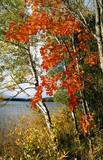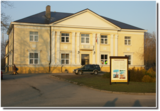| Нo | Название | Описание |
|---|---|---|
|
Labi redzams no Kornetu centra. Līdz tornim var nokļūt pa taku, kas ved pāri pļavai uz uzlokas pa stāvā Dzērves kalna nogāzi. No torņa paveras viens no skaistākajiem Vidzemes un Latvijas skatiem. Redzams Dēliņkalns, blakus esošie Dzērves un Ievas ezeri, Hānjas augstiene un Lielais Munameģis (acīgākiem vērotājiem). |
||
|
Замковая корчма «Черный поросёнок» - настоящая корчма средневековья в стенах Вентспилсского замка Ливонского ордена, вдоль которых несет свои воды река Вента. Корчма создавалась в соответствии со всем ансамблем замка, в котором расположился музей Вентспилса, но здесь отсутствует порядок, свойственный музею. Латышская кухня: Суп из баранины, жаркое из баранины, филе камбалы, жареная сельдь в масляной бумаге, домашние вина. |
||
|
Находится возле Руйиенской средней школы. Скульптура «Мадонна Оранс», созданная скульптором Карлисом Земдегом, установлена в 1936-м году в память утонувшей учительницы приходской школы Юлии Скуйини (24 года), о причине смерти которой ходят разные легенды. Одна из легенд связана с несчастной любовью к пастору Роберту Слокенбергу. |
||
|
Сааремаа может гордиться старинными, пережившими века и сохранившимися до сих пор традициями пивоварения. В Курессааре ‒ в здании с элементами арт-деко, где когда-то вырабатывали электричество, а сейчас открыта пивоварня Pöide ‒рождается искусство пивоварения. Здесь Вы узнаете множество секретов изготовления пива, а в отдельном помещении сможете продегустировать готовую продукцию. |
||
|
This area protects the landscape of the Lielauce hillocks, which are a part of the Eastern Kurzeme highlands. Lake Zebrus and Lake Svēte are in this territory. On the north-eastern shore of Lake Zebrus one can see the Ezerlūķi castle hill. On the eastern shore of the lake is a boating area, along with a viewing tower and a set of information about the area. The territory includes protected biotopes such as stream swamps and swampy forests, along with protected birds and species of bat. |
||
|
Хотя во время Первой мировой войны из 104 сельских домов было разорено 97, в тридцатые годы XX столетия Лапмежциемс быстро оправился, и здесь действовал один из мощнейших рыбацких кооперативов латвийского побережья. В советское время здесь был создан один из крупнейших рыболовецких колхозов «Селга», корпуса которого видны около устья Силиньупе. Современный Лапмежциемс – это излюбленный дачный район, место отдыха и купания. Интерес для туристов представляет памятник истории рыболовства - Лапмежциемский лодочный причал - бывшая пристань для рыбацких лодок, где рыбаки строили будки для сетей и хранили инвентарь. Между улицей Пиладжу и левым берегом Силиньупе за 3 - 2 тысячи лет до Рождества Христова находилась стоянка рыбаков и охотников, на месте которой установлен памятный камень. Это известное древнейшее поселение человека на территории национального парка «Кемери». Часть находок, обнаруженных при раскопках, можно увидеть в Лапмежциемском музее, где создана краеведческая экспозиция и собраны материалы о боях финских егерей в окрестностях Клапкалнциемса. |
||
|
К северо-востоку от Мазирбской лютеранской церкви – в полемежду храмом и домом «Пакални» видны два чумных камня. На поверхности бóльшего был высечен (сейчас стерся) текст о ливах, которых одолел король Швеции Карл IX и чума. Сбоку на большой камень опирается второй (самый маленький) чумной камень, который в свое время был установлен у близлежащих домов. Стертый текст рассказывал об армиях, ходивших по Курземе, о голоде и чуме. Третий – Большой чумной камень находится заМазирбским имением священника. Высеченный на нем текст (еще немного просматривается) повествует будущим поколениям о местном священнике (умер во время чумы) и о создании пастората в Сикрагсе. Одновременно камень является памятником шести пасторам обширной окрестной общины. Все три камня повествуют о Большой эпидемии чумы 1710 года, и тексты высечены на них в период с 1711 по 1734 год. |
||
|
Тропа создана на склоне основного берега древней долины реки Абава, где можно осмотреть рассредоточенное выклинивание подземных вод, различные типы лугов, можжевельниковые поляны и др. На береговом склоне весь год „хозяйничают” дикие коровы. 200 ступеней приведут вас к вершине берега древней долины, с которой открывается великолепный вид. Тропу рекомендуется посещать в сопровождении местного гида. |
||
|
Основным видом деятельности хозяйства является выращивание тюльпанов, в коллекции имеется около 400 различных луковиц тюльпанов. Весной проводится праздник тюльпанов, а осенью можно приобрести луковицы этих цветов. Небольшой зоопарк - пони, козы, кролики. Выпечка тортов, кренделей, пирогов и других лакомств. |
||
|
Brīvdienu mājas "Korķi” apkārtnes priežu mežā ir izveidota Jāņtarpiņu taka. Ideāla vieta aktīviem sēnotājiem un ogotājiem. Savukārt saules un jūras cienītāji pa šo taku 5-10 minūšu gājienā nonāks Vitrupes pludmalē, kur varēs baudīt sauļošanās un peldēšanās priekus.
|
||
|
Saimniecība specializējas uz dažādu dekoratīvo stādu audzēšanu nelielos apjopmos. Sezonas laikā pieejamas arī svaigas krūmmellenes, smiltsērkšķi, cidonijas, augļi un ogas. |
||
|
Блюда традиционной эстонской кухни из продуктов, произведенных в биологических хозяйствах Saare Ubin и Vatsliku. |
||
|
В этом туре вы увидите самые красивые места и города в регионе Видземе и национальный парк Гауя, такие как Сигулда с долиной реки Гауя, средневековый старый город Цесис и Валмиера. Вы будете полакомиться обедом Миллера, посетив работающую ветряную мельницу, исследовать сад с травами и огородами у средневекового замка, попробовать конопляное масло и пиво местной пивоварни Valmiermuiža. Вы попробуете «зеленый сыр», газированный напиток из березового сока, и сможете купить деликатесы из местного чеснока. |
||
|
Строительство замка в Валмиере было начато в 1283 году. Во время Северной войны (1702 год) замок сожгли, а в конце 17 века снесли внешние стены города. Сохранились развалины замка и другие остатки средневековых укреплений. |
||
|
Atrodas Burtnieka ezera austrumu krastā – uz ezera poldera dambja. Pavasara un rudens migrāciju laikā – laba putnu vērošanas vieta. Putni redzami ne tikai ezera piekrastē, bet arī poldera mitrajās pļavās. |
||
|
В "Баниши" черная смородина растет более чем на 3 гектарах, и хозяйка этого хозяйства уже много лет практикует популярный за рубежом метод, когда желающие полакомиться фруктами и ягодами сами приезжают на ферму и собирают необходимое количество ягод для собственных нужд. |
||
|
Atrodas ciema ziemeļdaļā. Neliela vienstāvu ēka ar svaigi nomainītu jumtu. Pēc vieniem avotiem celta 1883. gadā, citiem – pamatakmens ielikts 1933. g. 1. maijā. Tā tapusi pēc vietējo iedzīvotāju ziedojumiem uz Pirču māju zemes (saimnieks zemi atdevis dievnama celtniecībai). Baznīcas iekārta 2. pasaules kara laikā gāja bojā, tādēļ mūsdienās redzamā ir tapusi 20. gs. otrajā pusē. |
||
|
Моленная Крустцельской старообрядческой общины.
Моленная построена в 1939 году.
|
||
|
Находится на левом берегу реки Мемеле, 1,1 км севернее населенного пункта Бангас. Вилис Плудонис (1874 – 1940) был выдающимся латышским поэтом, представителем народного романтизма и учителем. Вилис Лейниекс (настоящее имя) родился в Бауском уезде в семье хозяина хутора «Лейениеки» Яниса Лейниека. На маленького мальчика уже в детстве оказали влияние сказки, рассказанные бабушкой, рассказы и народные песни. В. Плудонис похоронен на семейном кладбище (кладбище Плудоне), находящемся недалеко от дома (0,3 км). В «Лейениеки» создана экспозиция, знакомящая с жизненным путем и творчеством поэта. У Заячьей баньки ожидают зайцы – по мотивам стихотворения «Заячья банька». |
||
|
В 19 веке на побережье у Скулте выросла маленькая рыбацкая деревушка. Название Звейниекциемс (Рыбачий поселок) произошло от основного занятия его жителей. В 1967 году часть Скултского рыбачьего поселка присоединилась к городской части Скулте. Сегодня в Звейниекциемсе работает порт Скулте, который был торжественно открыт 7 октября 1939 года. Камень, который в качестве свидетеля строительства порта выбрал Карлис Улманис, все еще находится в Звейниекциемсе, а в порту активная деятельность ведется по сей день. Между портом Скулте и пляжем в Саулкрасты находится каменистый пляж Звейниекциемса. |
||

























